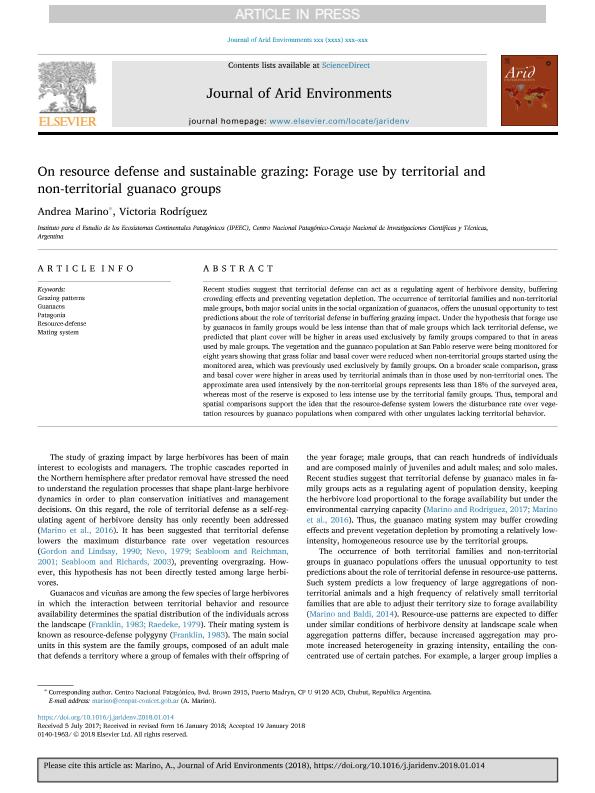Artículo
On resource defense and sustainable grazing: Forage use by territorial and non-territorial guanaco groups
Fecha de publicación:
05/2018
Editorial:
Elsevier
Revista:
Journal of Arid Environments
ISSN:
0140-1963
e-ISSN:
1095-922X
Idioma:
Inglés
Tipo de recurso:
Artículo publicado
Clasificación temática:
Resumen
Recent studies suggest that territorial defense can act as a regulating agent of herbivore density, buffering crowding effects and preventing vegetation depletion. The occurrence of territorial families and non-territorial male groups, both major social units in the social organization of guanacos, offers the unusual opportunity to test predictions about the role of territorial defense in buffering grazing impact. Under the hypothesis that forage use by guanacos in family groups would be less intense than that of male groups which lack territorial defense, we predicted that plant cover will be higher in areas used exclusively by family groups compared to that in areas used by male groups. The vegetation and the guanaco population at San Pablo reserve were being monitored for eight years showing that grass foliar and basal cover were reduced when non-territorial groups started using the monitored area, which was previously used exclusively by family groups. On a broader scale comparison, grass and basal cover were higher in areas used by territorial animals than in those used by non-territorial ones. The approximate area used intensively by the non-territorial groups represents less than 18% of the surveyed area, whereas most of the reserve is exposed to less intense use by the territorial family groups. Thus, temporal and spatial comparisons support the idea that the resource-defense system lowers the disturbance rate over vegetation resources by guanaco populations when compared with other ungulates lacking territorial behavior.
Palabras clave:
GRAZING PATTERNS
,
GUANACOS
,
PATAGONIA
,
RESOURCE-DEFENSE
,
MATING SYSTEM
Archivos asociados
Licencia
Identificadores
Colecciones
Articulos(IPEEC)
Articulos de INSTITUTO PATAGONICO PARA EL ESTUDIO DE LOS ECOSISTEMAS CONTINENTALES
Articulos de INSTITUTO PATAGONICO PARA EL ESTUDIO DE LOS ECOSISTEMAS CONTINENTALES
Citación
Marino, Andrea Ivana; Rodriguez, Maria Victoria; On resource defense and sustainable grazing: Forage use by territorial and non-territorial guanaco groups; Elsevier; Journal of Arid Environments; 152; 5-2018; 87-90
Compartir
Altmétricas




